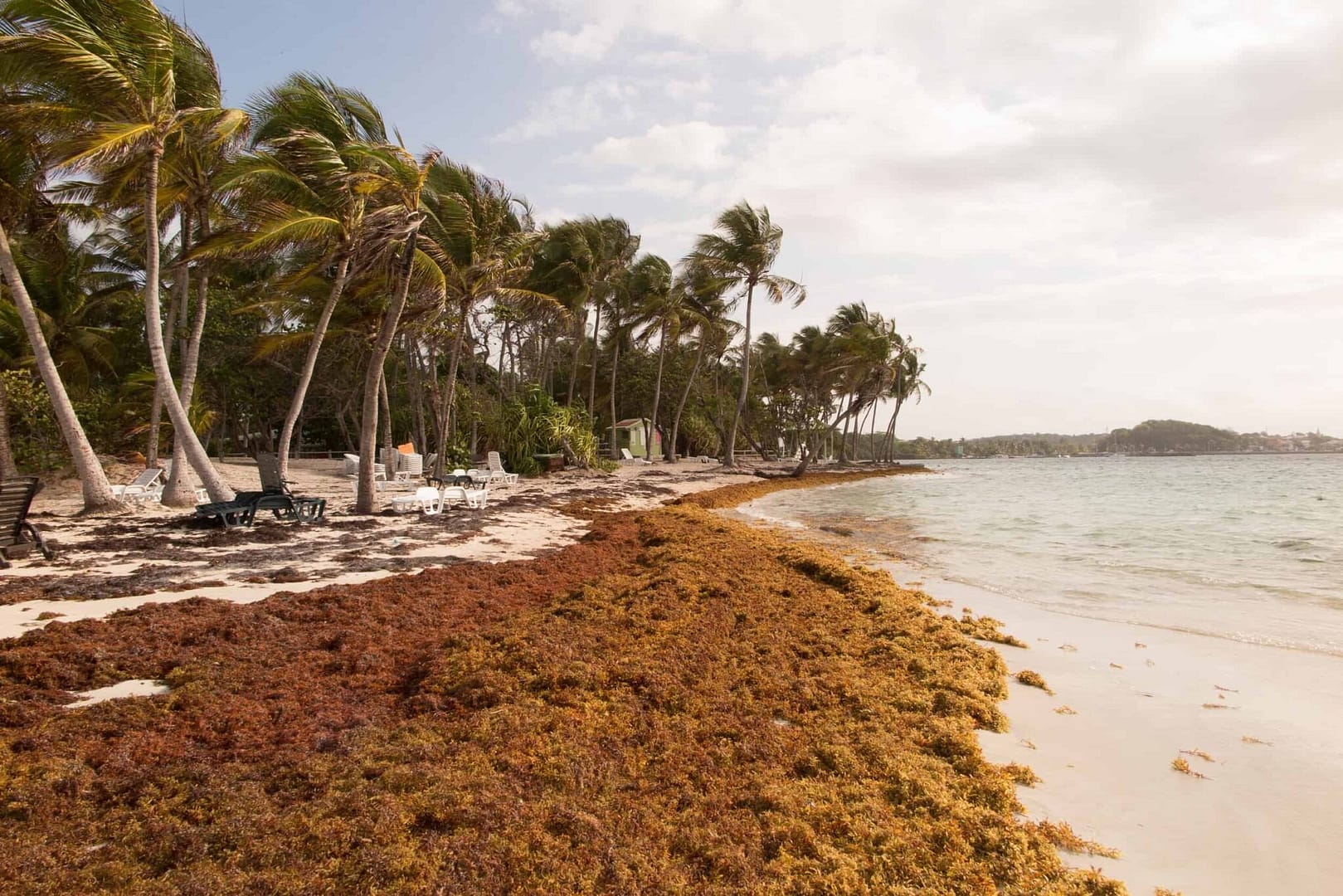
Sargassum, a golden opportunity
by Cdr. Bud Slabbaert
Yes, a golden opportunity for those who are smart. The key is to transform into treasure what most consider to be a nuisance and litter that is wrecking the region’s tourism-centered economies. Where others see it as a problem, the brainy and wise ones see it as an opportunity to turn it into a sustainable solution and treat sargassum as a resource to benefit fromrather than just trash left to rot or dispose of. What smells likerotten eggs can be smelled like something else: opportunity of harnessing the power of sargassum and shaping a world that thrives on nature’s bountiful offerings.
Sargassum can be upcycled it into some of the most effective products that support various industries. There are ways to curb the sargassum conundrum into a crucial and vital opportunity.
Many will think “Stop the nonsense right here, it stinks and ruinsour beaches”. Few will think: “wait a minute I see an opportunity to make good money, tell me more about it”.
Sargassum contains a number of beneficial components that can be extracted and used to create other products. You’ll be surprised. How about a cosmetic emulsifier? You know, a cream lotion that feels great on the skin and performs beautifully over time. Sargassum-based products offer natural antioxidants, vitamins, and minerals that nourish and revitalize the skin with its moisturizing and anti-aging properties, “I’m not going to put that stinky stuff on my skin!” No, neither are you putting crude oil into a fuel tank. It has to be refined first. Sargassum that touches coastlines and crude oil brought to earth’s surface can both be worst environment polluters, but they can be put to valuable use. Crude oil; black gold it was called. Sargassum itcould be called brown gold.
Sargassum building block and bricks. A suggestion for smart entrepreneurs in the construction industry inspired by the memory of adobe houses of natives. The block’s high potential in thermal conditions is favorable to be included in constructionsto reduce heat due to its fibrous structure. It can also be a useful element for sustainable and low-cost building. The seaweed is washed, dehydrated to demolish it, and, finally, powdered. The raw sargassum material, 40%, is joined with 60% of other organic materials in a mixture. A machine can turn out 1,000 blocks a day, and after four hours of baking in the sun, they are dried and ready to be used.
Leather-like and non-wovens from sargassum can be transformative achievements presenting a cruelty-free and eco-conscious alternative to traditional leather and textiles. An opportunity to write the future of fashion by providing less costly, vegan material alternatives. “How about more crazy suggestions?” Seaweed snacks! “What kind of medication are you on to suggest this?” In China and Japan, a popular way to enjoy ‘Sargassum Horneri’ is in the form of seaweed snacks. These snacks are made by roasting or frying seaweed to create a crispy and flavorful treat. They have a unique taste and nutritional benefits. They are often seasoned with various spices and can be enjoyed as a healthy alternative to traditional snacks.
So, instead of complaining start thinking of gaining. It would be wise to consider what else can be done with sargassum here than bringing it to the dump. To become smarter, think harder! Put some thought into the prospect of bio-material processing. Itcould be economy diversifying and offering new employment opportunities of a different kind. Not forgetting some export chances. It is an art to live sustainably and benefit from resources that nature provides us with. Finding ways to curb the sargassum challenge is a crucial and vital opportunity andbringing forth even more ingenious applications of seaweedupcycling while keeping the good elements of sargassum intact throughout any extraction process. Considerations for the future development of the sargassum industry.
Researchers are exploring the use of seaweed in the production of bioplastics as more sustainable alternatives to traditional plastics. Seaweed-based bioplastics are biodegradable, renewable, and have a lower carbon footprint compared to conventional plastics. It holds promise in reducing plastic waste.The pharmaceutical industry is increasingly recognizing the value of this seaweed in improving human health.
And talking about education opportunities for the youth of the islands. How about establishing an educational institute to research what the Caribbean has to offer from sargassum to aloe vera to hydrogen fuel generated from seawater. A breeding of young innovators and ingenious applications of Sargassum upcycling. Maybe just a humble start with a research laboratory financed by a philanthropist who enjoys visiting the islands and wishes them well.
Advertise with the mоѕt vіѕіtеd nеwѕ ѕіtе іn Antigua!
We offer fully customizable and flexible digital marketing packages.
Contact us at [email protected]


















Here we go again…make a illusion to be hard working and pay burden taxes in the name of green industry to the government. After your sweat your butt and dedicated a lot into nuisance…buolla!!! Copy cats will emerge as vampires
Let me give you some help is how cost work
To produce a concrete block we just need Sand, cement, water and (Not necessary) some type of additives to accelerate or delay curing time.
Right now in Antigua we have a mining area that have the capacity to provide sand for the coming decades without problem.
If we need to add another material to this mixture,how can you believe the price of the block will not increase significantly? Did you realize how experienced is to remove from the beach, transport to an area to dry, process it, then transport it to the block factory to replace a % of the sand for this product? Are you insane? You really are en delusional stage of your life and have no clue about construction, processing materials and how expensive such idea can be.
Don’t tell me. Tell the people in Mexico who are actually doing it. They market it successfully as “sargoblocks”. I’m not in the construction business and you are showing a significant weakness by becoming personal.
Unfortunately everyone will not be as opened minded as you are. There are indeed opportunities and thanks for sharing your perspectives. Hopefully these ideas will fall on more fertile ground.
@Arnaldo – you’re right. Here in the “States” corn is used to power our vehicles in the form of ethanol. It takes 2 dollars worth of energy to make 1 dollar of a polluting and inefficient fuel.
Our own govt sent a container of it to Germany or somewhere to explore the possibility of using it. There is someone from St lucia that is processing it as well. If nothing else, it can make fertilizer. Even if seaaweed products are not totally profitable, it’s still worth incentivizing, even subsidizing its removal because the seaweed affects one of our greatest national assists…our white sand beaches.
It was reported that five containers of fresh seaweed were sent to Finland to be used in the cosmetic industry.
@Cdr. Bud Slabbaert Another clue less delusional..
Build Block in Antigua (I dont care what other do in other country) is just simple cost
Sand+Cement+Water+Equipmnet RUnning cost= Block at 3.45 ec at Antigua Masonry Product
If I have to add another type of material like this. That have of course a cost per cu Yard that for sure it will be more expensive than regular Sand.
Sand+Cement+Water+Equipment running cost+(Cost of sargassum Material) = Block at ??? EC
You don’t see the problem here? How you dare to think you can produce cheaper Block adding something else?
How you dare to think you will not complicate the actual production scheme and increase the running cost of the Block factory final products just adding this New Materials?
Is just about Cost. Everything need to be evaluated as how much will cost to do it. And that is why some experience are profitable in some regions of the world and useless in others.
Comments are closed.